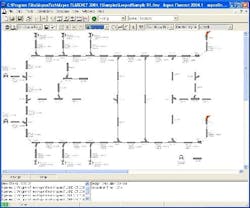“Fluid flow is the forgotten science in the chemical industry,” says Todd Willman, director of development and engineering with engineering software company EPCON International, Houston, Texas. By not understanding what is going on in a plant’s piping systems, engineers are in danger of “forgetting half the possibility of where you can make your process better,” he warns.
As Willman has highlighted before, the benefits of using pipeline simulation tools at the piping and instrumentation diagram (P&ID) level, rather than running simulations just on the process flow diagram, can often be overlooked. The problem, he says, is that chemical engineers “typically have significantly less ‘schooling’ in fluid mechanics principles” than their mechanical engineering counterparts, who tend to take charge of fluid flow analyses in other industries.
Leigh Gillard, Asia channels manager with Flowmaster International, Towcester, U.K. and Skokie, Ill., makes a similar point. Speaking of an application of his company’s pipe modeling software at BP’s complex at Hull, U.K., he says BP’s view was that many chemical engineers are “classically trained in production,” and so tend to ignore the mechanical effects of simply getting fluid from point A to point B — events such as valve slamming or pressure surges, for instance. “You can’t just specify a pipe and hope you get a flow down it. You have to take into account many other factors,” he notes.
That BP application involved a complete redesign of the utility services at the site, where steam, water, air and nitrogen pipe networks serve a variety of process plants producing a number of basic chemicals from acetic acid to oxygenated solvents. With Flowmaster in use there since 1993 (initially for transient surge analysis of incompressible fluids), BP’s engineers were well versed in how to build accurate design models of all the networks, models which are now continually in use to analyze the impact of prospective changes in the service requirements of each plant.
Flowmaster Version 6.5 was released in October 2005 with several enhancements to the basic one-dimensional package that was originally designed to analyze the fluid dynamic effects of fast-acting pressure transients (such as pressure surge and water hammer) in complex pipe networks. The main drivers behind its use in the chemical industry, according to Gillard, are basically asset management — “knowing which pipes are going where” — and simulation of flare and pressure-relief systems.
Tailored to chemical engineers
EPCON’s SiNET 7 software, which is part of the company’s Engineer’s Aide Toolbox suite, recently celebrated its 25th anniversary with a new edition that, says Willman, “fully completes the metamorphosis of taking a traditional mechanical engineering task to the ‘mainstream’ for chemical engineers in the chemical process industries (CPI).”
“If you use this technology right,” Willman notes, “you can find out all sorts of problems. We’re not trying to force a hydraulic, mechanical engineering view onto chemical engineers. We’re basically helping them to do the right calculations from their point of view.”
With options including access to AIChE’s DIPPR physical properties database of more than 2,000 components and EPCON’s own two-phase flash models, SiNET is said to be good for general-purpose pipeline network analysis and process equipment sizing and troubleshooting.
For its fluid-flow modeling modules, Applied Flow Technology, Woodland Park, Colo., offers the 700-component-strong Chempak database licensed from Madison Technical Software of Westwood, Mass. The basic module is AFT Fathom for incompressible-flow pipe network analysis and system modeling, complemented by AFT Arrow for studies of compressible fluids, AFT Mercury and Titan for incompressible- and compressible-flow system optimizations, respectively, and AFT Impulse for water-hammer/surge-transients analysis.
Noting that the software is used in just about every industry that has piping or ducting systems, Tom Glassen, AFT’s vice president, operations, finds it somewhat surprising that application of pipe flow network analysis in the chemical industry is “still at a relatively early stage, not nearly as extensive as, say, the use of pipe stress analysis tools.” Many engineers, he believes, are still using “relatively crude tools based on spreadsheets,” although he is now seeing steady growth in the adoption of piping flow analysis software. “Companies that take it up,” he says, “soon appreciate the benefits of better design and fewer problems later on in operation…”
This gradual uptake is also recognized by Michael Blondin, sales and marketing manager of Engineered Software, Lacey, Wash. Its flagship product is Pipe-Flo, which started out life more than 20 years ago as a tool primarily for engineering design firms. Blondin says the current customer split has now swung around to being nearer 40% operators and 60% design firms. “We’ve seen a shift in probably the past 10 years,” he notes, “as we’ve moved to sophisticated Windows-based solutions and graphical interfaces, P&IDs and so on, trying to make the program as easy to use as possible. In many cases we work both with the design firm and then also with the end user, so that the Pipe-Flo model will apply throughout the life of the system.”
One end user can thank Pipe-Flo for a $40,000/year saving in energy costs. Bill Kane, manufacturing technologist at the Monsanto plant in Luling, La., used the software to optimize the plant’s compressed air system. “You wouldn’t have time or the expertise to do this type of analysis without Pipe-Flo,” he says. “These types of projects get more complicated as you get more people involved, so using the working model in Pipe-Flo made communication easier.”
Engineered Software has arranged with around 80 pump manufacturers to incorporate their pump curve data into a web-based pump selection module for Pipe-Flo. The company also is in the process of linking its software into other process applications such as distributed control systems (DCSs).
Multiphase flow
At the moment, Pipe-Flo is only applicable to single-phase flows, but that’s under review, says Blondin, given “a strong customer base in the CPI interested in multiphase flow.” AFT also is considering multiphase. “It’s an area for which, on the one hand, there is a regular demand, but, on the other, it’s a relatively small demand,” Glassen notes. Most users wanting to do two-phase modeling at the moment are more interested in single flows rather than complex networking studies, he finds.
Flite Software, Derry, Northern Ireland, has recently expanded the application of its FluidFlow3 simulation software into the realms of two-phase and compressible flow and added some heat-transfer capabilities. The program, developed by a team of chemical engineers, boasts many features that should be of particular interest to users in the CPI. For example, networks containing non-mixing multiple fluids, such as cooling water and process streams, can be analyzed within the same flowsheet.
The fn-PRO version of the FlowNet software from Engineering Design System Technology, San Francisco, Calif., has offered gas/liquid two-phase flow capabilities for a couple of years now. Multiphase calculations are performed automatically without having to manually enter vapor/liquid properties and compositions, says principal John Cheng. A version of the software now is available for modeling non-Newtonian flow. Current developments under way for the fn-PRO program include heat-loss modeling (through piping insulation, for example), heat-exchanger network analysis, and an fn-FLARE module for flare and knockout-drum applications.
Meanwhile, ABZ Inc., Chantilly, Va., has found the market for its fluid flow analysis program, Design Flow Solutions, broadening over the years. “Different users want different outputs, so we are looking at making the program more user-configurable so they can choose their own settings and options,” says co-owner and founder Warren Brewer. Outputs can now include a complete bill of materials report listing all components used in each branch of a network.
Specialized software vendors aren’t the only ones addressing pipe network analysis. Indeed, two of the largest process simulation vendors — Aspen Technology, Cambridge, Mass., and Invensys SimSci-Esscor, Lake Forest, Calif. — also offer their own particular takes.
For instance, the Aspen Hydraulics suite of products, while aimed mainly at upstream oil and gas applications, can deal with transient and dynamic flow problems. For both up- and downstream, Aspen FlareNet (Figure 1) can model typical flare or vent systems involving several hundred interconnecting elements.
Invensys SimSci-Esscor offers Inplant, a rigorous steady-state simulator for designing, rating and analyzing plant piping systems — from process pipes to steam and utility distribution systems to flare relief networks. “A nice thing about Inplant is that it can do rigorous three-phase flow, everything from simple bulk properties to rigorous thermodynamics,” says Jim Browne, upstream technology director for the Inplant business and the related Pipephase program for upstream applications.
Tie-in with CFD
He says many customers use a package like Inplant or Pipephase to set up a model and then run through a series of “case studies” or scenarios to identify areas where they’re pushing constraint limits. “They can then examine those areas in more detail using CFD (computational fluid dynamics) tools — almost using Inplant as a screening tool.”
For the moment, Inplant doesn’t have an interface with any of the proprietary CFD packages, although Browne says “one of the companies we have been looking at is Fluent.” Now a comment like that from one of the major control vendors is usually enough to send rumors of mergers and acquisitions spreading around the industry like wildfire. But as Fluent, Lebanon, N.H., was acquired in May by ANSYS, Canonsburg, Pa., SimSci-Esscor’s interest is clearly co-operational.
Inplant wouldn’t be the first pipe-network-analysis software to link into Fluent, however. Flowmaster, for instance, has interfaces with both Fluent and Star-CD, the CFD code from CD-adapco, Melville, N.Y. and London, U.K.
Fluent’s business development manager for oil and gas and chemicals, Daniel Burton, says CFD can come into pipeline design when you need to consider factors much more complex than just the pressure drop down the line. “Areas where we have worked recently have included erosion and corrosion studies within pipelines in refineries, for example.”
Although Fluent 6.3 was released in beta version in December 2005, Burton says the main changes recently have been not so much in software development but rather in working on “more customizable versions of the software, where we can work with clients to design an interface for them so they can move CFD from the specialists and out to process engineers, for instance. The Fluent code then interfaces with their existing CAE (computer aided engineering) tools, with CFD very much going on in the background.”
In a similar vein, CD-adapco has “for the past few years been concentrating on ways of providing very easy front ends to our software,” says technical marketing manager Stephen Ferguson. One of these is STAR-Design, which, he notes, is “like a simple solid-modeling CAD package that anybody can pick up. It’s not like ten years ago when you probably needed a Ph.D. to run CFD programs. The idea behind this sort of simple analysis is that you can do it from a PC without having to understand Navier-Stokes equations.”
Of course, what can be done on a PC today would have stretched the imagination of any engineer 10 years ago. And the pace of change shows no sign of slackening. For instance, Comsol, Burlington, Mass. and Stockholm, Sweden, released in March the latest 64-bit version of its Multiphysics simulation tools, based on the rapid solving of partial differential equations — including, of course, Navier-Stokes. With support for the forthcoming 64-bit Windows platform, users of Multiphysics 3.2a reportedly will be able to increase the size of simulation models on their PCs by “orders of magnitude.”
Whether such power is needed for pipe network analysis is debatable, of course. EPCON’s Willman still says “you can solve a whole lot of problems — especially in the energy and utilities areas — by doing the simple analyses. We don’t want to get away from just giving the engineers out there tools that are simple to use.” No doubt in their own way, the likes of Comsol, Fluent, CD-adapco, AspenTech and SimSci would all agree with that sentiment.



